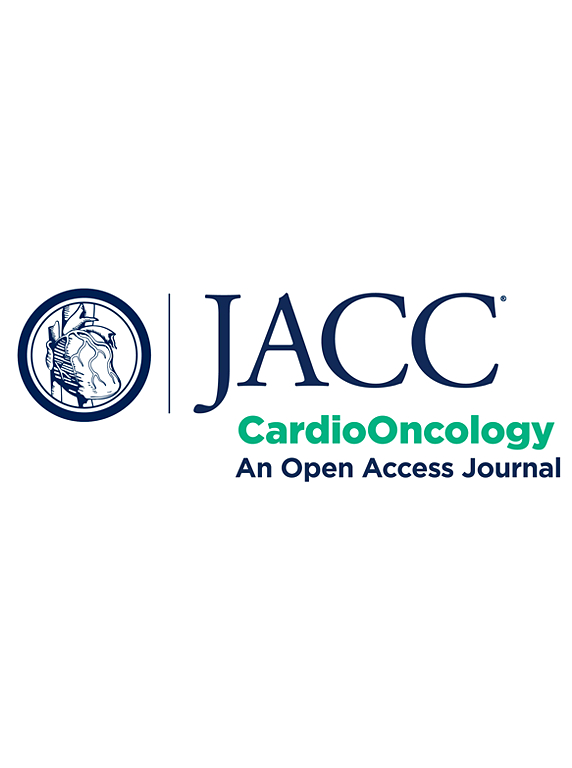既往虚弱对接受辅助治疗的乳腺癌患者心脏毒性的影响
IF 12.8
1区 医学
Q1 CARDIAC & CARDIOVASCULAR SYSTEMS
引用次数: 0
摘要
背景先前的研究表明,患有高虚弱负担的乳腺癌患者可能面临更高的心脏毒性风险。目的本研究旨在探讨女性乳腺癌术后接受辅助治疗的患者虚弱和心脏毒性发生率之间的关系。方法分析来自OneFlorida+临床研究网络的数据,重点分析2012 - 2022年接受辅助化疗和靶向治疗的乳腺癌患者。辅助治疗期间的心血管发病率是基于预先存在的虚弱来计算的,使用累积缺陷虚弱指数(电子健康记录虚弱指数)来测量。我们采用多变量格雷方法来检验虚弱与心脏毒性之间的关系。最终队列包括2050例患者(平均年龄50.6岁),其中415例(20.2%)在辅助治疗后出现非致命性心血管不良事件。不良心血管事件的发生率在健全人组为17.8%,体弱前期为23.2%,体弱组为29.4%。在多变量分析中,预脆弱(调整后的子分布)HR [sHR]: 1.35;95% ci: 1.06-1.71;P = 0.015)和虚弱(调整后sHR: 1.70;95% ci: 1.11-2.61;P = 0.015)患者与健康患者相比,出现不良心血管事件的可能性更高。在非西班牙裔白人和黑人患者中,虚弱前期(调整后的sHR: 1.48;95% ci: 1.04-2.11;p = 0.031;调整后sHR为1.59;95% ci: 1.06-2.37;P = 0.024)和虚弱(调整后sHR: 1.96;95% ci: 1.10-3.50;p = 0.022;调整后sHR: 2.13;95% ci: 1.11-4.10;P = 0.023),与健康的患者相比,患者更容易发生不良心血管事件。在其他种族/族裔群体中未观察到显著差异。结论在接受辅助治疗的虚弱乳腺癌患者中,需要密切监测心脏毒性,以改善心血管风险管理。本文章由计算机程序翻译,如有差异,请以英文原文为准。
Impact of Pre-Existing Frailty on Cardiotoxicity Among Breast Cancer Patients Receiving Adjuvant Therapy
Background
Prior research suggests that breast cancer patients with a high burden of frailty may face an increased risk of cardiotoxicity.
Objectives
This study sought to examine the association between frailty and cardiotoxicity rates in female breast cancer patients receiving adjuvant therapy after surgery.
Methods
We analyzed data from the OneFlorida+ clinical research network, focusing on breast cancer patients treated with adjuvant chemotherapy and targeted therapy from 2012 to 2022. Cardiovascular rates during adjuvant treatments were calculated based on pre-existing frailty, measured using the cumulative deficit frailty index (electronic health record frailty index). We employed multivariable Gray’s method to examine the association between frailty with cardiotoxicity.
Results
The final cohort included 2,050 patients (mean age 50.6 years), with 415 (20.2%) experiencing nonfatal adverse cardiovascular events after adjuvant therapy. The incidence of adverse cardiovascular events was 17.8% in robust, 23.2% in prefrail, and 29.4% in frail patients. In multivariable analysis, prefrail (adjusted subdistribution HR [sHR]: 1.35; 95% CI: 1.06-1.71; P = 0.015) and frail (adjusted sHR: 1.70; 95% CI: 1.11-2.61; P = 0.015) patients had a higher likelihood of experiencing adverse cardiovascular events compared with robust patients. Among non-Hispanic White and Black patients, prefrail (adjusted sHR: 1.48; 95% CI: 1.04-2.11; P = 0.031; and adjusted sHR: 1.59; 95% CI: 1.06-2.37; P = 0.024, respectively) and frail (adjusted sHR: 1.96; 95% CI: 1.10-3.50; P = 0.022; and adjusted sHR: 2.13; 95% CI: 1.11-4.10; P = 0.023, respectively) patients were more likely to experience adverse cardiovascular events compared with robust patients. No significant differences were observed in other racial/ethnic groups.
Conclusions
These findings highlight the need for close monitoring of cardiotoxicity in frail breast cancer patients undergoing adjuvant treatments to improve cardiovascular risk management.
求助全文
通过发布文献求助,成功后即可免费获取论文全文。
去求助
来源期刊

Jacc: Cardiooncology
Multiple-
CiteScore
12.50
自引率
6.30%
发文量
106
期刊介绍:
JACC: CardioOncology is a specialized journal that belongs to the esteemed Journal of the American College of Cardiology (JACC) family. Its purpose is to enhance cardiovascular care for cancer patients by publishing high-quality, innovative scientific research and sharing evidence-based knowledge.
The journal aims to revolutionize the field of cardio-oncology and actively involve and educate professionals in both cardiovascular and oncology fields. It covers a wide range of topics including pre-clinical, translational, and clinical research, as well as best practices in cardio-oncology. Key areas of focus include understanding disease mechanisms, utilizing in vitro and in vivo models, exploring novel and traditional therapeutics (across Phase I-IV trials), studying epidemiology, employing precision medicine, and investigating primary and secondary prevention.
Amyloidosis, cardiovascular risk factors, heart failure, and vascular disease are some examples of the disease states that are of particular interest to the journal. However, it welcomes research on other relevant conditions as well.
 求助内容:
求助内容: 应助结果提醒方式:
应助结果提醒方式:


